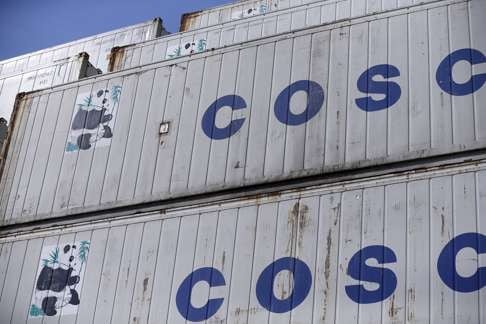
China’s Cosco bleeds more as shipping pain worsens
Shipping giant China Ocean Shipping Group (Cosco) swung into the red with a net loss of 4.48 yuan in the first quarter, as the shipping industry worldwide hit a new low on weak trade and falling commodities prices.
Cosco, which has just formed the world’s largest shipping alliance with three other major players this month to buffer the protracted downturn in the industry, blamed the loss on a steady decline in rates due to “severe imbalance of supply and demand”.
It had incurred a loss of 1 billion yuan in the same period last year but had managed to post a full-year profit of 283 million yuan thanks to government subsidies. Excluding one-offs from asset disposals, Cosco’s non-recurring loss in the first quarter was 2.14 billion yuan while operating revenue fell 19.6 per cent to 14.6 billion yuan.
CLSA analyst Daniel Meng said he was not surprised by Cosco’s losses. “The number is not small, but not extraordinarily big given its track record.”
During the first three months of the year, international freight rates as indicated by the Shanghai Containerized Freight Index (SCFI) fell 47 per cent year on year as excess capacity continues to plague the industry and oil prices languish. The SCFI hit 400.43 on March 18, the lowest since 2009. Baltic Dry Index, an index for dry bulk shipping, was 41.6 per cent lower year on year and 44 per cent lower quarter on quarter.
Struggling shipping companies have been consolidating and forming alliances to optimise network and share capacity. Through subsidiary Cosco Container Lines, Cosco on April 20 signed an agreement with France’s CMA CGM, Taiwan’s Evergreen, and Hong Kong’s OOCL to form “Ocean Alliance”, which will see them combine 350 ships from next April.

Cosco said an ongoing merger of its container shipping business with former rival China Shipping Group’s China Shipping Container Lines (CSCL) has already driven costs down in that segment. But despite a 14.8 per cent volume rise from asset restructuring, revenue from container shipping fell in all markets in the first quarter except China domestic. That on transpacific routes declined the most, by 18.8 per cent.
Meng said freight rates may pick up slightly as oil prices rebound and the months of May and June are traditionally mini peak periods, but the spike would not be significant. “Industry supply-and-demand is not expected to change much within the year. It will remain tough. How things will be next year will depend more on EU and US growth, rather than China’s.”
Cosco could “easily” incur losses of 1 billion yuan in each quarter in its container shipping business unless it exercises exceptional cost controls, he added.
Immediate impact from the new alliance “would likely be negligible” but could change if carriers consolidate more volumes, Citi said in a recent report.

